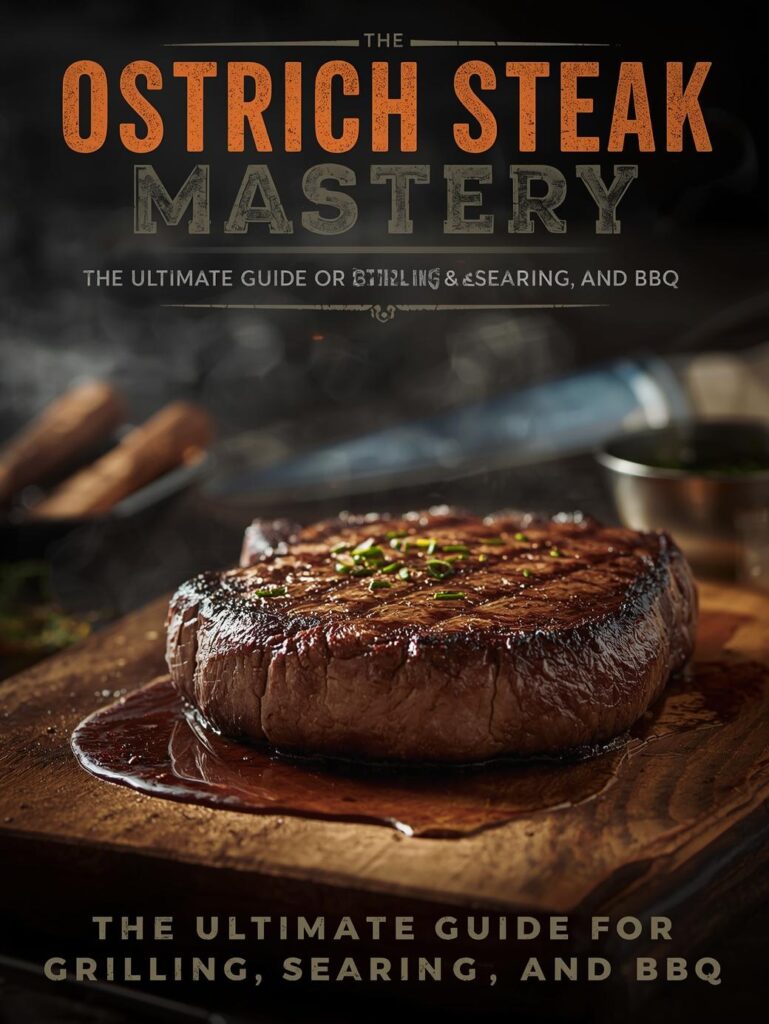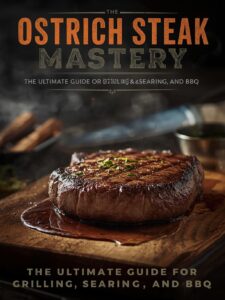The Red Meat of the Bird World: Ostrich isn’t just an alternative to chicken—it’s a nutritional powerhouse that looks, cooks, and tastes more like premium beef than poultry. With a deep red color, a flavor reminiscent of lean filet mignon, and a fat content that would make a bodybuilder jealous, ostrich challenges everything you think you know about bird meat. This is your guide to mastering the fastest, leanest, and most surprising meat on two legs.
Ostrich Steak Mastery: The Ultimate Guide to Grilling, Searing, and BBQ
“Ostrich is the culinary chameleon of the meat world. It has the leanness of bison, the color of venison, and the delicate flavor of a fine beef tenderloin. Cooking it is a lesson in precision and restraint. Where beef forgives, ostrich demands. Where pork is generous with its fat, ostrich is frugal. Master this paradox, and you unlock a protein so healthy and so elegant it feels like you’ve discovered a secret the rest of the meat world is still searching for.”
Ostrich Steak Mastery: The Ultimate Guide to Grilling, Searing, and BBQ
Download Our Ostrich Meat Quick-Reference - Cuts, Cooking Times & Flavor Pairings
Forget everything you know about poultry. Ostrich meat is a brilliant red, not white, and it’s so lean it makes chicken breast look indulgent. This is a meat of contradictions: it’s a bird that eats like a steak, a flightless giant that cooks in minutes, and a health food that delivers five-star restaurant flavor. Whether you’re a fitness enthusiast seeking the ultimate lean protein or a curious carnivore looking for your next great steak experience, this guide will transform ostrich from a mysterious novelty into a regular in your meat rotation.
🎯 OSTRICH VS. BEEF: THE NUTRITIONAL SUPERPOWER
The numbers don’t lie—ostrich is in a league of its own.
🦴 OSTRICH ADVANTAGE
- 97% Lean: Almost no marbling or internal fat
- Less than Half the Fat of skinless chicken breast
- High in Iron & B-12: Rivals or exceeds beef
- Low Cholesterol: Heart-healthy profile
- High Protein Density: More protein per calorie
❌ COMMON MISCONCEPTIONS
- “It’s gamey” → Tastes like lean, mild beef
- “It’s tough” → Becomes tough only if overcooked
- “It’s exotic & weird” → Farmed in the US, easy to find online
- “It tastes like chicken” → Tastes like fine beef, looks like venison
- “Hard to cook” → Cooks fast, just don’t walk away
🔪 THE OSTRICH BUTCHER’S GUIDE: KNOW YOUR CUTS
Treat it like beef, not chicken, for the best results.
🎯 Ostrich Cut Masterclass
🎯 From Tender Steaks to Flavorful Grind
| Cut | Description | Best Cooking Method | Doneness Temp | Beef Equivalent |
|---|---|---|---|---|
| Fan Fillet (Tenderloin) | The most tender cut, from the inner thigh | Sear, grill, roast | Rare to Medium-Rare (120-130°F) | Beef Tenderloin/Filet Mignon |
| Top Loin Steak | Lean, flavorful, great marbling (for ostrich) | Grill, pan-sear | Rare to Medium-Rare (125-135°F) | Strip Steak |
| Ostrich Medallions | Small, cross-cut slices from various muscles | Sauté, quick grill | Rare to Medium (120-140°F) | Beef Medallions |
| Ground Ostrich | Lean grind from trimming | Burgers, meatballs, chili | Well-Done (160°F) for safety | 93/7 Lean Ground Beef |
| Ostrich Roast | Larger muscle from leg or hip | Reverse sear, low-temp roast | Medium-Rare (130-135°F) | Eye of Round Roast |
| Ostrich Strips | Thin-sliced for stir-fry | Stir-fry, fajitas, Philly cheesesteak | Medium (140°F) | Beef Stir-fry Strips |
🌡️ THE DONENESS DILEMMA: RARE OR RUIN
With ostrich, temperature isn’t a preference—it’s a commandment.
⚡ The Ostrich Temperature Commandments
There is No Margin for Error
- Rare (120-125°F): Cool red center. Maximum juiciness and the most delicate texture. Ideal for fan fillet.
- Medium-Rare (125-135°F): Warm red center. The sweet spot for most cuts, balancing safety and tenderness.
- Medium (135-145°F): Warm pink center. Acceptable for those hesitant about red meat, but moisture loss begins.
- Medium-Well (145-155°F): Slightly pink center. Noticeably drier and beginning to toughen.
- Well-Done (160°F+): Gray throughout. DO NOT DO THIS with steaks or roasts. The result will be dry, tough, and disappointing. Reserve well-done only for ground ostrich. Full temperature guide here.
🔥 COOKING METHODS: PRECISION OVER POWER
Ostrich’s leanness demands specific techniques to achieve perfection.
🍳 THE PERFECT PAN-SEAR
For Steaks & Medallions
- Hot Pan, High Smoke Point Oil: Use avocado or grapeseed oil. The pan should be smoking hot.
- Season Just Before: Salt draws moisture. Season right before it hits the pan.
- Sear 2-3 Minutes Per Side: For a 1-inch steak. Don’t move it—let a crust form.
- Baste with Butter & Herbs: Add butter, garlic, and thyme for the last minute, tilting the pan and spooning over the steak. Pan-searing mastery.
🔥 THE ULTIMATE GRILL
For Loin Steaks & Roasts
- Two-Zone Fire is Mandatory: You need a hot zone for searing and a cool zone to finish without burning. Two-zone guide.
- Oil the Meat, Not the Grate: Prevents sticking without flare-ups from oil dripping.
- Sear, Then Move: 2 minutes per side over direct heat, then move to indirect to reach target temperature.
- Use a Thermometer: Do not guess. Pull 5°F below target temp—carryover cooking is real.
🧂 THE FLAVOR STRATEGY: COMPLEMENT, DON’T OVERPOWER
Ostrich’s delicate flavor is a canvas for subtle, elegant seasoning.
🎯 Ostrich Flavor Pairing Matrix
Building Bridges with the Delicate Flavor
- Earthy & Savory: Mushrooms (especially porcini), garlic, shallots, rosemary, thyme. Classic pairings that enhance the meat’s natural savoriness.
- Bright & Acidic: Red wine reduction, balsamic glaze, citrus zest, pomegranate. Cuts through the leanness and adds vibrancy.
- Sweet & Fruity: Cherry sauce, fig jam, port wine reduction, grilled peaches. Complements the mild sweetness in the meat.
- Spicy & Smoky: Green peppercorn sauce, smoked salt, chipotle rub (used sparingly). Adds dimension without overwhelming.
- Rich & Creamy: Gorgonzola butter, cognac cream sauce, horseradish crème fraîche. Adds the fat that the meat lacks. Sauce guide here.
🚨 OSTRICH TROUBLESHOOTING: FIX COMMON MISTAKES
🎯 Ostrich Cooking Rescue Guide
| Problem | Cause | Immediate Fix | Prevention |
|---|---|---|---|
| Tough & Chewy | Overcooked | Slice very thin against the grain, serve in a salad or sandwich with a moist sauce. | Use a digital thermometer; pull at 125°F for rare. |
| Dry & Grainy | Overcooked + no added fat | Dice and use in a stir-fry or hash with plenty of oil and vegetables. | Baste with butter or oil during cooking; cook to medium-rare max. |
| Lacks Flavor | Underseasoned, mild cut | Serve with a flavorful compound butter or reduction sauce. | Be generous with salt just before cooking; use a flavorful rub. |
| Sticks to Grill/Pan | Not enough oil, not hot enough | Let it cook; it will release when a crust forms. | Ensure cooking surface is screaming hot; oil the meat, not the surface. |
| Burnt Outside, Raw Inside | Heat too high, cut too thick | Finish in a 400°F oven until target temp is reached. | Use two-zone cooking; reverse sear for thick cuts. Reverse sear guide. |
🏁 THE LEAN, RED REVOLUTION
Ostrich isn’t just another meat—it’s a paradigm shift. It proves that “healthy” and “decadent” can exist on the same plate. It challenges the notion that lean protein must be bland and that spectacular steak must be marbled with fat. By mastering ostrich, you’re not just adding another item to your menu; you’re expanding your entire philosophy of what meat can be.
Start with a simple pan-seared fan fillet. Respect its need for rare doneness. Pair it with a classic red wine sauce. You’ll be amazed at how something so lean can be so satisfying. Ostrich is the secret weapon for the health-conscious gourmand and the final frontier for the curious carnivore. It’s time to think outside the chicken.
Continue your journey into the world of unique and flavorful proteins
No posts selected. Please provide either "slugs" or "ids" parameter.
Expand Your Meat Horizons: Deepen your knowledge with these essential guides.



